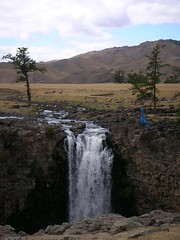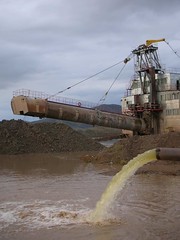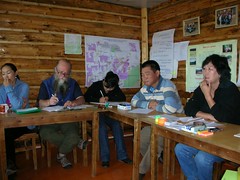- Blog
- Mining Tourism in Mongolia
Mining Tourism in Mongolia
Donate Now!
Your contribution will benefit Friends of the Earth.
Stay Informed
Thanks for your interest in Friends of the Earth. You can find information about us and get in touch the following ways:
A Journey Through Environmental Degradation

Mongolia is arguably the last pristine country in Asia. Its modest 2.5 million people are spread among the vast prairie steppe, desert plains, forests and mountain areas that, geographically, make up the world’s fourth largest country. They share this unique landscape with an equally diverse range of plants and animals, including new species of spiders, mice and medicinal plants that scientists recently discovered in the country’s northern forests and rare and endangered species of large fish that are no longer found in natural environments anywhere outside of Mongolia. 
Increasingly, our guides and their countrymen and countrywomen are aware of another reason they can appreciate their land: for the mineral rich earth below the surface. Large deposits of gold, copper, coal, oil and other minerals have all been found in Mongolia in the past decade and with them, the possibility of economic prosperity. One of the largest mineral deposits being explored right now is the Oyu Tolgoi Copper deposit in the South Gobi. The exploration area is larger than Florida and the annual profit from output could double Mongolia’s present GDP.
Many believe the increase in GDP could be a blessing for the country, particularly since structural adjustment policies to convert Mongolia into a market-based economy that began in 1990 have failed to bring economic prosperity to the vast majority of the country. It has, however, succeeded in bringing growing frustration about significant income disparity, high levels of unemployment among young males, official corruption, and lack of social services such as healthcare, education and welfare. Just two months before the start of the trip, exasperation with these issues seemed to be at a boiling point as people took to the streets of the capital after Parliamentary elections, decrying election fraud and manipulation by some political candidates and their powerful backers.
The Mining


Rural communities and herders are often the first to feel the impacts of irresponsible mining. An 80-year-old woman told us that she could no longer drink the water near her ger because a mining company was using it to power their operations. Herders told us that they increasingly search in vain for pasture to feed their animals after the rivers and lakes began drying up. Community members vented their anger about mining companies that brought hardship to them without paying a penny in taxes on the land they dug up or the profits they garnered.
The Economics of Mining
Multinational companies often play a key role in Mongolia’s mining sector. The majority of investment in Mongolia’s medium and large-scale mining operations are from foreign sources, including China, Russia, Canada and Japan. The Canadian-owned Ivanhoe Company is prospecting one of the largest copper mines in the world at Oyu Tolgoi. Mining investments from China have helped make it the country’s largest trading partner, accounting for around 40% of Mongolia’s total foreign direct investment. This has included an unconditional USD 300 million loan and over USD 790 million investment 
Despite the presence of international stakeholders in all aspects of Mongolia’s mining, little attention is paid to international standards such as the Extractive Industries Transparency Initiative (EITI). The Mongolian groups I met with indicated that they are increasingly concerned about the mining activities of Chinese companies. According to the groups, these companies frequently use mercury, and sometimes cyanide, in the extraction of gold. These chemicals are used in order to increase the amount of gold that can be extracted from land that has already been raked over. The chemicals present significant health and environmental concerns when not properly handled. There have been several chemical spills in rivers, and humans and animals have been exposed to toxins.
Working Towards a Solution
As bad as mining in Mongolia seems, there are indications that it is still relatively contained. Of the 6,000 mining licenses issued by the government so far, the vast majority are for exploration, while only 1,000 are for extraction. As one mining industry professional put it, “the mining boom hasn’t even begun.” However, the country is indeed on the cusp, particularly if those exploration licenses turn to extraction licenses. The worry among Mongolian citizens is that the impact on communities from relatively limited mining has been substantial, and an increase in mining will be devastating. If this is just the beginning of the ‘mining boom,’ then what future hope is there for the country’s fragile ecosystem?

International environmental organizations can help as well, by advocating for increased cooperation in sustainability work between Mongolian civil society groups and stakeholders from the countries that play a role in the mining industry. One of the ways Friends of the Earth can help the Mongolian river movements is to address the poor practices of transnational mining companies in our work on sustainable trade and investments. In particular, Friends of the Earth-US is well placed to raise the profile of the Mongolians’ concerns about Chinese investment in their country because of our program work on Chinese overseas investments and sustainable finance. In these ways we hope to help our Mongolian colleagues realize sustainable development for their people and a healthy planet for us all.
